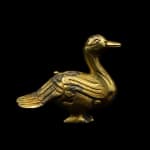Han Dynasty figure of a Goose, 206 BCE - 220 CE
Gilt bronze
height 7.6 cm
height 3 in
height 3 in
ES.4487
Further images
This miniature yet ornate figure of a recumbent goose is shown with a slender, elegant neck with its head extended forward exposing a gentile expression. Finely cast feathers decorate the...
This miniature yet ornate figure of a recumbent goose is shown with a slender, elegant neck with its head extended forward exposing a gentile expression. Finely cast feathers decorate the body of the waterfowl protecting its bent legs and attractive webbed feet. The rear reveals its swept-back wings and relaxed tail with further overlapping feathers.
Within the canon of Chinese history, geese were not traditional farmyard animals, so their depictions were far rarer than other birds. Being migratory animals, they were perceived as a manifestation of the principle of yin-yang; flying away from the shadow (yin) to follow the sun (yang). For this particular reason, they are often interpreted as an embodiment of Dao Dualism, a fundamental teaching encompassing native animistic beliefs and doctrine. Similarly, Geese bare an important place in Classical Chinese poetry. Examples of goose imagery have a significant place in prose, in particular during the Han era, as evidenced through Shijing also known as the Classic of Poetry.
The Han Dynasty (206 BCE-220 CE) was the second imperial dynasty of China and one of the longest major dynasties in Chinese history. In modern terms of military and political power and cultural prestige, the Han Dynasty is currently considered to have rivalled its almost contemporary Roman Empire in the West. With only minor interruptions, it lasted over four centuries and was considered a golden age in Chinese history, especially in arts, politics and technology. All subsequent Chinese dynasties looked back to the Han period as an inspiring model of a united empire and self-perpetuating government.
Within the canon of Chinese history, geese were not traditional farmyard animals, so their depictions were far rarer than other birds. Being migratory animals, they were perceived as a manifestation of the principle of yin-yang; flying away from the shadow (yin) to follow the sun (yang). For this particular reason, they are often interpreted as an embodiment of Dao Dualism, a fundamental teaching encompassing native animistic beliefs and doctrine. Similarly, Geese bare an important place in Classical Chinese poetry. Examples of goose imagery have a significant place in prose, in particular during the Han era, as evidenced through Shijing also known as the Classic of Poetry.
The Han Dynasty (206 BCE-220 CE) was the second imperial dynasty of China and one of the longest major dynasties in Chinese history. In modern terms of military and political power and cultural prestige, the Han Dynasty is currently considered to have rivalled its almost contemporary Roman Empire in the West. With only minor interruptions, it lasted over four centuries and was considered a golden age in Chinese history, especially in arts, politics and technology. All subsequent Chinese dynasties looked back to the Han period as an inspiring model of a united empire and self-perpetuating government.









